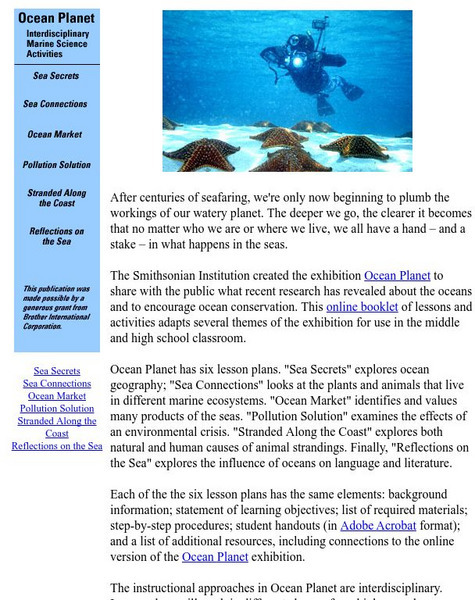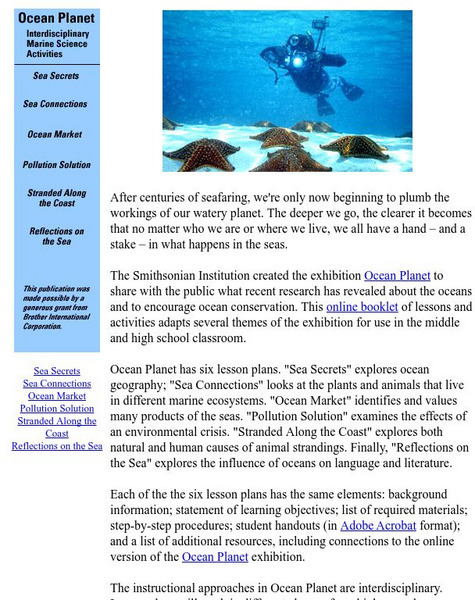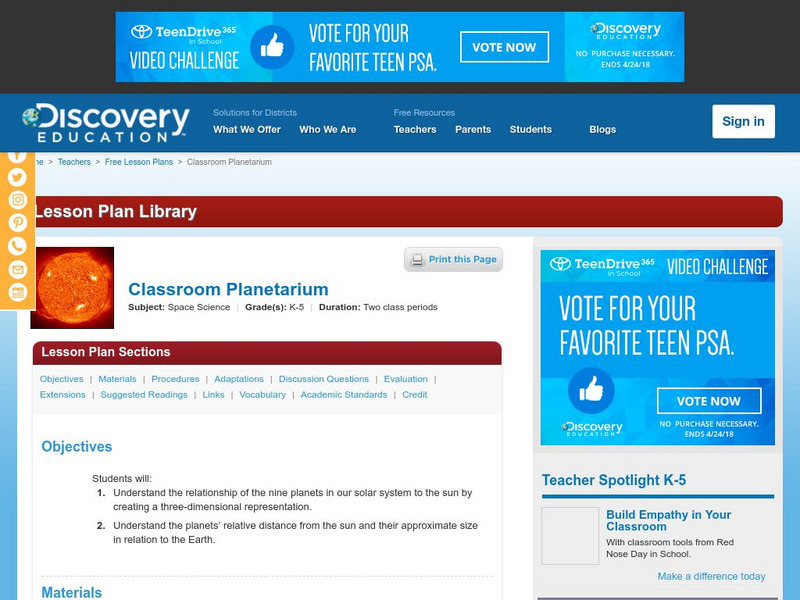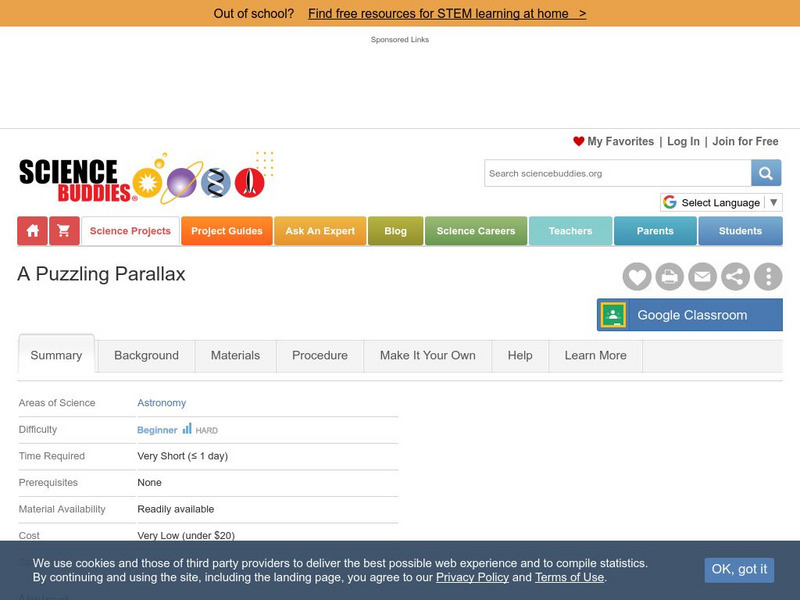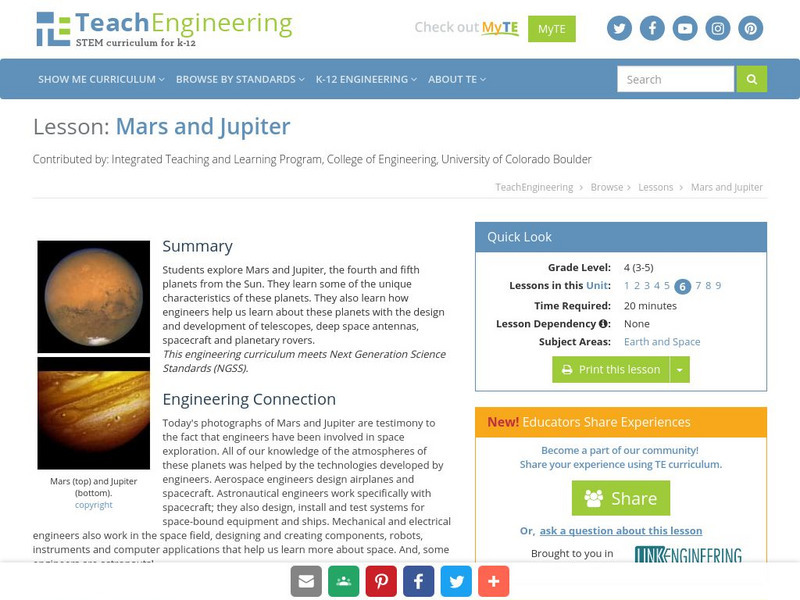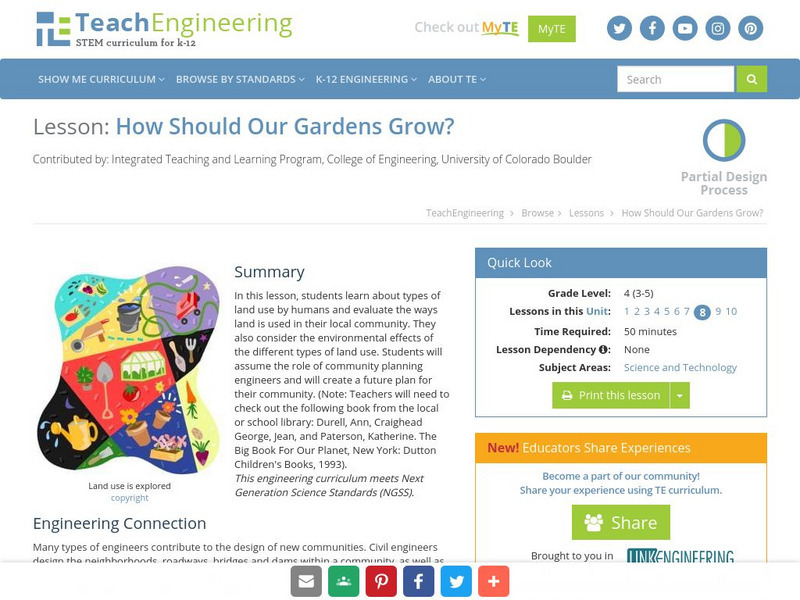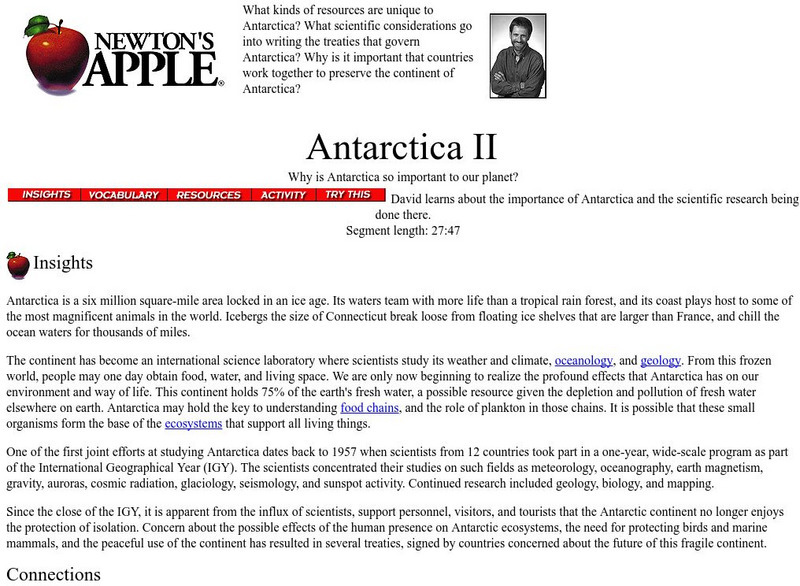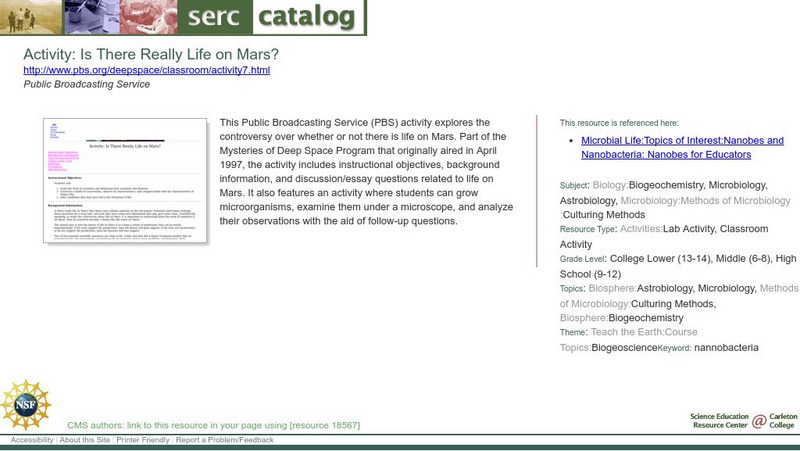Smithsonian Institution
Smithsonian Education: Ocean Planet
A series of lesson plans designed to be used with the Smithsonian Ocean Planet exhibit (available online). Lesson topics include marine ecosystems, pollution of ocean water, animal strandings, and literature.
Smithsonian Institution
Smithsonian: Ocean Planet: Interdisciplinary Marine Science Activities
Smithsonian Institution presents ?Ocean Planet: Interdisciplinary Marine Science Activities?. Through this series of six interdisciplinary lessons, students will look at such things as the organisms in different marine ecosystems, the...
PBS
Pbs Learning Media: Solar System Scale Model
Teach the concept of scale models and the size of the solar system through this extensive lesson plan. Students will learn about scale models, estimate which objects to use to create a scale model of Earth and Sun, and figure out how far...
PBS
Pbs Teachers: Life's Really Big Questions: Planetary Problem Solving
Explore the possibility of life on planets outside our solar system. Create an extrasolar planet, then make the necessary adaptations for it to be capable of supporting human life.
Alabama Learning Exchange
Alex: If Earth No Longer Existed. . .
Middle schoolers will work in cooperative groups to research characteristics of each of the planets in our solar system. Students will design a travel brochure outlining the characteristics of each planet. Each group will make an oral...
Alabama Learning Exchange
Alex: Planetary Cereal Project
This is a project which would be appropriate to use at the end of a lesson about the solar system. Young scholars will decorate an empty cereal box with information and games showing their comprehension of factual information about an...
University of Texas at Austin
The University of Texas Mc Donald Observatory: Rock Cycle
This activity combines the concept of Earth's rock cycle with the characteristics of other planets in the solar system.
Discovery Education
Discovery Education: Classroom Planetarium
Create a classroom model of the solar system while teaching about relative size of all the planets, and each planet's distance from the sun.
Alabama Learning Exchange
Alex: Our Restless Planet
This unit will use demonstrations and student examples to help students gain an understanding of rotation, revolution, and orbit. Through hands-on activities students will explore the concepts of day and night. Technology will be...
Science Buddies
Science Buddies: A Puzzling Parallax
Did you know that ancient astronomers could measure the distance to other stars? They could also distinguish between stars and planets. How could they do that without modern technology of telescopes? See if you can discover the link...
Better Lesson
Better Lesson: Our Sky
What objects are in the day sky and the night sky? How do they seem to move? Come and explore with us as we discover the sun, moon, planets and stars! This detailed lesson plan includes pictures and videos of the lesson in action,...
TeachEngineering
Teach Engineering: Mercury and Venus
Students explore Mercury and Venus, the first and second planets nearest the Sun. They learn about the planets' characteristics, including their differences from Earth. Students also learn how engineers are involved in the study of...
TeachEngineering
Teach Engineering: Mars and Jupiter
Students explore Mars and Jupiter, the fourth and fifth planets from the Sun. They learn some of the unique characteristics of these planets. They also learn how engineers help us learn about these planets with the design and development...
Other
Making a Scale Model of the Solar System
In this lesson plan site, students are asked to construct a scale model of the planets to help visualize the relative size of planets and their relative distance from the Sun. Links are provided to the Sun and the planets which contain...
PBS
Pbs Teachers: Math Space Odyssey: How Much Do You Weigh in Outer Space?
Demonstrate the ability to apply the use of decimals, fractions, ratios and proportions to situations based upon given information about planets in the solar system.
TeachEngineering
Teach Engineering: How Should Our Gardens Grow?
In this lesson, students will learn about types of land use by humans and evaluate the ways land is used in their local community. They will also consider the environmental effects of the different types of land use. Students will assume...
TeachEngineering
Teach Engineering: Blazing Gas
Young scholars are introduced to our Sun as they explore its composition, what is happening inside it, its relationship to our planet (our energy source), and the ways engineers help us learn about it.
TeachEngineering
Teach Engineering: Fresh or Salty?
Between 70 and 75% of the Earth's surface is covered with water and there exists still more water in the atmosphere and underground in aquifers. In this instructional activity, students learn about water bodies on the planet Earth and...
Council for Economic Education
Econ Ed Link: Destination: Mars
Look up! Can you ever imagine standing on another planet and looking down at earth? We've been to the moon - now lets launch an expedition to Mars. Imagine all the preparation you will have to go through in order to have a safe and...
Alabama Learning Exchange
Alex: What's Going on and Where Am I?
For this lesson, middle schoolers write a descriptive essay about an historical event as seen through the eyes of an alien from a different planet and time. The lesson encourages the use of colorful and exciting adjectives, adverbs, and...
PBS
Pbs Teachers: Scientific American: Journey to Mars: Getting There
Explore the usefulness of space probes by comparing an unmanned probe's accuracy with human observation. Design a planet surface with varied features, and then create probes to discover features of the planet's surface.
Michigan Reach Out
Michigan Reach Out: Antarctica Ii
This site provides basic reasons for Antarctica's importance to our planet. Students can create their own treaty of governance for Antarctica.
Science Education Resource Center at Carleton College
Serc: Activity: Is There Really Life on Mars?
This Public Broadcasting Service (PBS) activity explores the controversy over whether or not there is life on Mars. Part of the Mysteries of Deep Space Program that originally aired in April 1997, the activity includes instructional...
PBS
Pbs Teachers: Mysteries of the Universe
Consider the issues surrounding the world of space exploration including the new fields of archaeoastronomy and astrobiology. Investigate zero gravity, the Big Bang theory, life in space and how sound travels in a vacuum.
Other popular searches
- Lesson Planet
- Planet Earth
- Inner and Outer Planets
- Worksheets Planets
- Paper Mache Planets
- Inner Planets
- Nine Planets
- Planet Earth Dvd Series
- The Planets
- Imaginary Planets
- Planet Acrostic Poem
- Laws of Planetary Motion
